

National School Leadership Standards Map. World-Readiness Standards for Learning Languages. Download Two-Page Summary of the World-Readiness Standards for Learning Languages Download Summary World-Readiness Standards Available for Purchase Purchase print or eBook Standards book with eBooks of all available languages.Purchase print Standards book with one eBook of these language-specific documents: Purchase All Languages Purchase One Language.
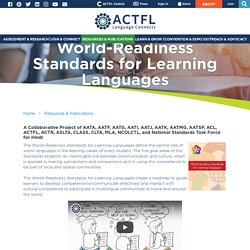
New Jersey Student Learning Standards. New Jersey Student Learning Standards In 1996, the New Jersey State Board of Education adopted the state's first set of academic standards called the Core Curriculum Content Standards.
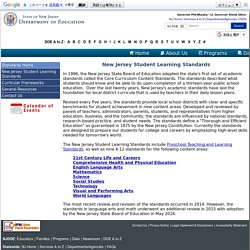
The standards described what students should know and be able to do upon completion of a thirteen-year public school education. Over the last twenty years, New Jersey's academic standards have laid the foundation for local district curricula that is used by teachers in their daily lesson plans. Revised every five years, the standards provide local school districts with clear and specific benchmarks for student achievement in nine content areas.
Developed and reviewed by panels of teachers, administrators, parents, students, and representatives from higher education, business, and the community, the standards are influenced by national standards, research-based practice, and student needs. Common Core State Standards. About this Site This site is the official home of the Common Core State Standards.
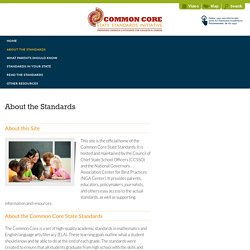
It is hosted and maintained by the Council of Chief State School Officers (CCSSO) and the National Governors Association Center for Best Practices (NGA Center). It provides parents, educators, policymakers, journalists, and others easy access to the actual standards, as well as supporting information and resources. About the Common Core State Standards The Common Core is a set of high-quality academic standards in mathematics and English language arts/literacy (ELA). For years, the academic progress of our nation’s students has been stagnant, and we have lost ground to our international peers. ISTE Standards.
National Health Education Standards - SHER. Skip directly to A to Z list Skip directly to navigation Skip directly to page options Skip directly to site content Related Links Healthy Youth Get Email Updates To receive email updates about this page, enter your email address: CDCCDC Healthy Schools National Health Education Standards Recommend on Facebook Tweet The National Health Education Standards (NHES) were developed to establish, promote and support health-enhancing behaviors for students in all grade levels—from pre-Kindergarten through grade 12.
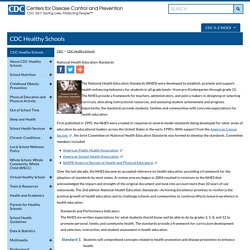
First published in 1995, the NHES were created in response to several model standards being developed for other areas of education by educational leaders across the United States in the early 1990's. NCSS National Standards for Social Studies Teachers. Revised 2017 The 2017 revision of the National Standards for the Preparation of Social Studies Teachers became operational on January 1, 2018.
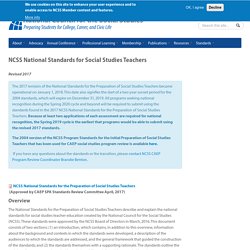
This date also signifies the start of a two year sunset period for the 2004 standards, which will expire on December 31, 2019. All programs seeking national recognition during the Spring 2020 cycle and beyond will be required to submit using the standards found in the 2017 NCSS National Standards for the Preparation of Social Studies Teachers. Because at least two applications of each assessment are required for national recognition, the Spring 2019 cycle is the earliest that programs would be able to submit using the revised 2017 standards. The 2004 version of the NCSS Program Standards for the Initial Preparation of Social Studies Teachers that has been used for CAEP social studies program review is available here. If you have any questions about the standards or the transition, please contact NCSS CAEP Program Review Coordinator Brandie Benton.
National Core Arts Standards. National Standards for Arts Education Kindergarten through 4th grade. National Science Teaching Association (NSTA) Next Generation Science Standards. ACTFL Performance Descriptors for Language Learners. The ACTFL Performance Descriptors for Language Learners are designed to describe language performance that is the result of explicit instruction in an instructional setting.
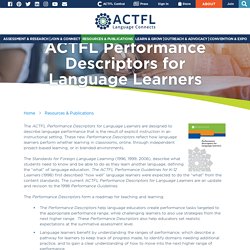
These new Performance Descriptors reflect how language learners perform whether learning in classrooms, online, through independent project-based learning, or in blended environments. The Standards for Foreign Language Learning (1996, 1999, 2006), describe what students need to know and be able to do as they learn another language, defining the “what” of language education. The ACTFL Performance Guidelines for K-12 Learners (1998) first described “how well” language learners were expected to do the “what” from the content standards. Principles and Standards - National Council of Teachers of Mathematics. This practical guide includes three 11" x 17" sheets to display the expectations across the four grade bands for each of the five Content Standards: Number and Operations, Algebra, Geometry, Data Analysis and Probability, and Measurement.
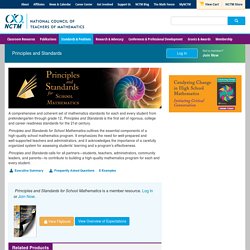
(eBook) Connecting the NCTM Process Standards & the CCSSM Practices (PDF) Connecting the Standards, Improving Mathematical Instruction By connecting the CCSSM to previous standards and practices, the book serves as a valuable guide for teachers and administrators in implementing the CCSSM to make mathematics education the best and most effective for all students. Linking assessment to everday classroom instruction requires a shift in both thinking and practice.
For many, the term assessment simply means grade. To help teachers, parents, administrators, and others better understand Principles and Standards, NCTM has compiled a document containing answers to questions regarding its purpose and content. NCTE (English Language Arts) Music Content Standards ( NAMM Foundation) InTASC Model Core Teaching Standards and Learning Progressions for Teachers 1.0. CCSSO, through its Interstate Teacher Assessment and Support Consortium (InTASC), is pleased to offer this set of combined resources that both define and support ongoing teacher effectiveness to ensure students reach college and career ready standards.
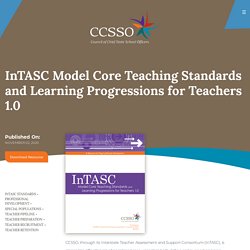
This document includes the InTASC Model Core Teaching Standards: A Resource for State Dialogue, which were released in April 2011, and the new InTASC Learning Progressions for Teachers 1.0: A Resource for Ongoing Teacher Development (2013). Together they describe the new vision of teaching needed for today's learners, how teaching practice that is aligned to the new vision develops over time, and what strategies teachers can employ to improve their practice both individually and collectively.